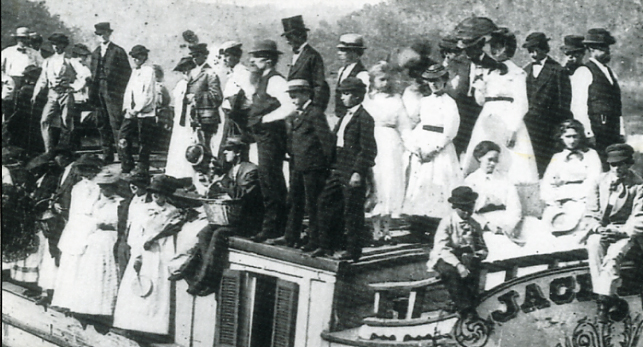
This rear section of the canal boat, JACK BOYLE, shows the main party discussed in this Milestones.
Click Here to Return to Milestones

Editors Note--This issue of Milestones is
almost exclusively dedicated to an article researched and written
by Harold Boyer. We are very impressed by the subject, the depth
of research, and the conclusions reached. Mr. Boyer has spent
approximately ten years working on the evidence presented here.
He has traveled around the country to gather information and opinions.
We think he makes a good argument, but it is ultimately up to
the reader to decide on the astounding conclusions presented here.
Much has been written about newly-elected
President Abraham Lincoln of 1860 and his February, 1861, inaugural
trip to the nation's capital, which included an overnight stay
and a speech in Pittsburgh plus a stop at Freedom and Rochester
in Beaver County
A new discovery strongly indicates that the President and Party
made a brief and secret visit to an isolated area north of Beaver
Falls ten weeks after the early March inauguration. It is well
known that much had happened historically during those early weeks
of Lincoln's presidency including the firing on Ft. Sumter, the
siege of Washington and the arrival of northern troops to defend
the capital.
Much emotion was experienced by this writer in the mid 1990s when
I purchased a box of photographic plates from the Marx Estate
Auction in Beaver Falls. This lot included glass plate negatives
of canal boats, locks and bridges plus a quarter plate original
ambrotype photograph of a docked canal boat named JACK BOYLE.
A large group of people were on the boat posing on a bright sunny
day with strong mid-day shadows and partially grown new foliage
visible to trained eyes. According to Mrs. Marx, her late husband
acquired this box of images from an unidentified, to date, Patterson
Heights, Beaver Falls, client where he was performing carpentry
work in the 1960s.(1)
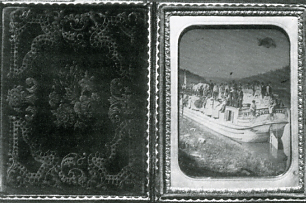
This excitement increased greatly after years of careful research
which resulted in the identification of at least eleven persons
in the boat.(2) As detailed later in this article, those firmly
recognized are: President Lincoln and his two youngest sons, William
Wallace and Thomas; two famous Lincoln bodyguards; one of the
President's three secretaries; several relatives of Mary Todd
Lincoln; a local friend of the Lincoln family, Dr. David Metheny;
and a young hometown buddy of Willie Lincoln from Springfield,
Illinois.
It is still unknown who the photographer was for this historically
important picture. However, inasmuch as a glass plate in this
purchased collection included a photographic scene of a photographer's
identified wagon used by well-known photographer Henry Noss of
New Brighton, it is believed Mr. Noss may have been the picture
taker.(3)
Initial credit for the success of this discovery is being given
to present professional photographers Harry K. Frye of Beaver
and Terry Clark of Ambridge for their superb darkroom skills of
creating an enlarged paper print from the ambrotype by projecting
through the glass image with a large antique enlarger so that
identities could be more easily accomplished.
Long-term studies with the help of many local historians have
determined that this remarkable boat photo had been exposed in
mid May 1861 on the west side of a very isolated bend of the Beaver
River one mile north of the present roundhouse building at approximately
27th St., Beaver Falls. This would make the boat-scene site over
the hill from 42nd St. This river's edge area is still isolated
today.
During the winter months without the obstructing foliage, modern
photos were taken at the site which resulted in an unbelievable
closeness in the three dimensional background of today as compared
to the ambrotype of one hundred forty-two years ago.(4) The lead
evidence to seeking this site were the published articles in early
issues of The Geneva Alumnus newsletter by the late Geneva College
Historians Clarence McCartney and J. Vale Downie, and in older
issues of this journal, the Milestones.
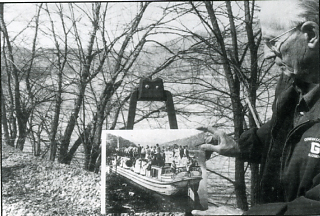
Doctors McCartney and Downie had described Captain Boyle's
canal boat as being still docked near the bend in the river north
of the college.(5) The boat was owned by John Boyle of New Brighton
who became postmaster of that town after the canals and boats
were replaced by railroads in the 1850's.(12)
The history of the Beaver Canal System of the 1830s to 1850s is
well known with its many locks between Rochester and New Castle,
Pennsylvania. Famous persons had traveled in this slow-moving
transportation. They included Charles Dickens, James Fenimore
Cooper, Zachary Taylor and James Garfield as a young boat tender.
These people, with little doubt, stayed overnight at Metheny's
Tavern (on the river north of Beaver Falls) or at least stopped
long enough for a cooked meal before continuing their journey
in the canal systems.(5)
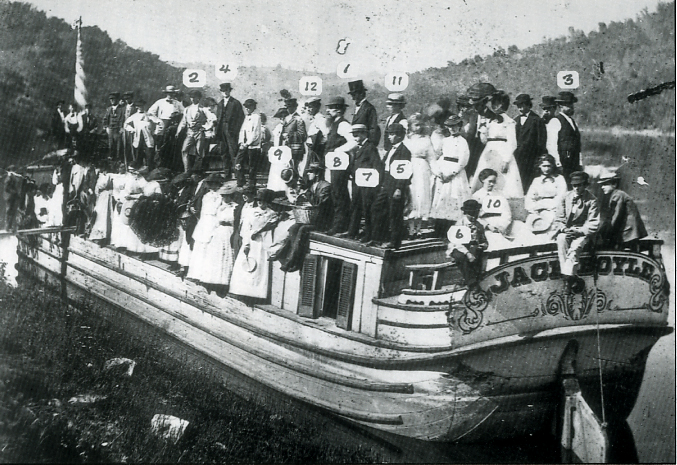
Using a number system, those identified in the boat picture with
some related information are as follows:
No. 1. President Abraham Lincoln
Lincoln began growing his beard in November, 1860, with it developed
in May 1861 as in the boat picture. It is compared with the published
Mathew Brady portraits of the President taken between February
1861 and 1862 of both studio and field picture takings.
No. 2. Colonel Elmer Ellsworth
Assigned temporarily as a bodyguard to Lincoln for the inaugural
trip and for this quick visit to Beaver County and return. With
the threat of war, this young and devoted friend of the Lincolns
formed a Zouave military outfit of New York Firemen to help defend
Washington. He was killed on May 24, 1861, during a march into
Alexandria, Virginia, which is believed to be only seven to ten
days after this canal boat photo was taken.
No. 3. Ward Hill Lamon
Mr. Lamon was a lawyer and a friend of Abe in Springfield. He
was appointed as the President's chief bodyguard and later as
Marshall of the District of Columbia. He was sometimes called
"Barrel-chest Lamon" for his bigness and strength, plus
the fact that he was known to carry many concealed weapons.
No. 4. David Metheny, MD (1836 - 1897)
Dr. Metheny was of the Metheny family of the Beaver Falls area;
his grandparents (Moses and Hannah Metheny) helped raise him and
were the operators of Metheny's Tavern and Hotel at the junction
of the Beaver River and the Connoquenessing Creek in northern
Beaver County. Dr. Metheny finished medical school in the spring
of 1861, had a brief practice in Pittsburgh, was a doctor in the
US Army for a short duration and then was appointed by President
Lincoln as Medical Consul to Syria in 1864.(5)
The Metheny's in Beaver Falls were related to the Metheny's in Springfield where Lincoln's office was above Metheny's General Store. James M. Metheny was Abe's best man at the Abe and Mary wedding in 1842. N. W. Metheny issued their marriage license as being a clerk of courts of Sangamon County, Illinois.(5)
No. 5. Willie (William Wallace) Lincoln
(1850-1862)
Willie was eleven years old in this photo of May 1861. He died
the following February, 1862, reported as being caused by typhoid
fever. A son of the Lincolns, he was named after Mary Todd Lincoln's
brother-in-law William Wallace.
No. 6. Tad (Thomas) Lincoln (1853-1871)
Tad was the youngest of the Lincoln sons. He died at age 18 in
1871. Tad was age 8 in this photo of 1861.
No. 7. Albert Edwards
Young Albert was a special friend of Willie Lincoln; notice they
are standing side-by-side in the boat scene. Albert's parents
were Ninian and Elizabeth Todd Edwards.
No. 8. Lockwood Todd
Lockwood was either an older nephew or a cousin to Mary Todd Lincoln.
He was popular with the Lincoln boys but not with the President
because of their differences on the subject of slavery and due
to Lockwood's outspoken and embarrassing remarks on political
issues.
No. 9. Francis Todd Wallace
Mrs. Wallace was a half-sister to Mary Todd Lincoln. Her husband
was Dr. William Wallace of Springfield.
No. 1O. Margaret Todd Kellogg
Mrs. Charles Kellogg was a half-sister to Mary Todd Lincoln.
No. 11. Unidentified
This young man resembles Levin Handy who was a nephew to famous
photographer Mathew Brady of Washington and New York. Levin was
an apprentice photographer at this time and eventually took over
Brady's Studio after the war when Mathew's eyesight worsened.
Levin was a Washington acquaintance of the Lincoln boys.
No. 12. John Hay (1838-1905)
John Milton Hay was the President's second secretary. Even with
the serious defect in the ambrotype negative in front of his face,
John's identification has been firmly established as being the
secretary that Lincoln selected for this slip away trip.
Hay later graduated from Brown University and their library is
named after him. He became ambassador to Great Britain and Assistant
Secretary of State during his later career.
Note: The other Lincoln secretaries were John Nicolay and William
Stoddard. At the time of this brief trip, Nicolay was on special
assignment to Monroe Fortress, and Stoddard was on temporary military
duty in Washington.
The identifications of the above eleven
people were done with painstaking efforts and considering their
true appearances at the month and year of the picture taking.
This writer has thirty-five years' experience of collecting photographica
and twenty years specializing in identifying famous people in
early images. This experience was applied when comparing the photograph
with published control portraits in numerous books of better reference
libraries with my favorite research places being the McCartney
Library at Geneva College, the Davis Library at the University
of North Carolina, the USF Library at the University of South
Florida, the Research Center in the Beaver Falls Carnegie Library
building, plus my own library of books.(2)
With all of the above relating mostly to the what, where and who,
I must now address the how and why.
As was briefly mentioned in a beginning paragraph, our country
in 1861 was in a turmoil over the different views of slavery.
Compromises between the Abolitionists and Pro-slavery politicians
were not fulfilling. Hence, on April 14, 1861, the southern artillery
fired onto Ft. Sumter. Shortly after, a siege of Washington began
and southern sympathizers in Maryland sabotaged the railroads
and the telegraph lines north of the Capital. Lincoln called hastily
for troops from northern states to defend Washington and to restore
the railroads and the telegraph system.(6)
The troops arrived sparingly by outfits and in sufficient force
by May 10. Washington was again considered safe, at least temporarily.
During the siege, everyone at the White House had cabin fever:
The President had been making frequent short-distance security
trips to the War Department building where the main telegraph
station was set up (with the help of young Andrew Carnegie from
Pittsburgh) and where Secretaries of War Simon Cameron and Edwin
Stanton plus Secretary of State William Seward had busy offices.(7)
Mary Lincoln had delayed her planned trip to New York to select
new furnishings for the White House, and many Todd relatives had
been stranded in Washington with no safe way to return to Springfield.
During the brief calm in Washington (from about May 10 to approximately
May 20, 1861) the President apparently made a hasty decision (after
presumingly conferring with his cabinet secretaries at the War
Department) to accompany the previously marooned Todd relatives
part way to Springfield with the turn around point for him, his
sons, his secretary and his bodyguards being the Metheny Hotel
in Beaver County, Western Pennsylvania. By this period in time,
the hotel was also now used as a railroad station. After a brief
visit in the northern Beaver Falls area, the Todds are believed
to have continued on for the balance of their journey; and the
smaller Lincoln Party was whisked back to Washington, actually
to Camp Lincoln which was reasonably close to the War Department
and the White House.
Based on (1) circumstantial remarks made in early books including
those by authors Ruth Painter Randall and Gore Vidal that "The
LincoIns just disappeared in mid May," (2) the very noticeable
gap of no letters written by President Lincoln and by Secretary
Hay between May 11 and 19, 1861, and (3) Secretary Stoddard writes
later in his autobiography that when he visited the White House
while on guard duty during this same period, "the Lincoln
rooms are empty." (8)
It is stated with confidence that the Lincoln Party left Camp
Lincoln in Washington on May 12 or 13 and returned to Camp Lincoln
on May 19 or 20. The return date was critical because of the planned
march into Alexandria by Ellsworth's Zouave troops. That march
of troops began from Camp Lincoln on March 23 with Ellsworth getting
killed on March 24 during an episode of the young colonel removing
a Confederate flag from a roof top.
Noticeably, Mrs. Lincoln is not in the boat picture. It is documented
that she left Washington on about May 10 with a smalI party to
shop in New York and to visit her oldest son, Robert, at Harvard.
She, too, is believed to have returned on May 19 or 20. There
are reports that the President and wife were in flag dedication
ceremonies in Washington on May 21 and 22.(9,10)
The route used by the train to Beaver County could have been the
B&O Railroad from Baltimore to Wheeling then to Beaver Falls,
or by some route to Harrisburg then to Beaver County. One can
assume the means of last- minute communicating for this quick
trip was through the restored telegraph system and possibly using
coded messages. According to the very good book, Lincoln in the
Telegraph Office by James A. Fawley and David Homer Bates, Andrew
Carnegie helped create a code system used at that time, and Lincoln
had spent hours in the telegraph office in the War Department.(7)
I would like to thank many people for their help on this complex
project. Rex Downie stands high among those who encouraged me
along the way. Rex, a retired attorney, enjoys doing historical
writing and helping people with research projects. Other local
people and sources of information not already mentioned in this
article are: Retired Professor David Carson of Geneva College;
the staff of McCartney Library at Geneva; Dr. William Irion and
Ms. Betty Conner at the History Center, Beaver Falls; Mr. Samuel
Allen of the Carnegie Library, Beaver Falls; Dr. Harry Farra of
Geneva, who has strong interest in local history; Mrs. Theodora
Downie Koble, whose grandfather, Dr. David Metheny is in the canal
boat photograph; Ms. Heather Metheny, who is doing research on
the Metheny family; Mr. Kenneth Britten of the Beaver Falls Historical
Society; the Library personnel at the History Center in Pittsburgh;
and the editors of the Milestones, Denver Walton and Charles Townsend.
Did President Lincoln use good judgment in leaving Washington
during the brief relaxation at the capital in mid May 1861 for
a trip that may not have been essential considering the circumstances
of the war? I am one who says he should not have accompanied the
stranded relatives and friends part way to their hometown destinations
even with the temporary calm. Perhaps he would agree with me.
And perhaps political considerations was the reason it was kept
a secret. There apparently is no government document or private
letter written specifically on the subject, just the outstanding
photograph with identified people and with the times and locations
being pinpointed, plus the many strong circumstantial and documented
evidences regarding the gap of time and brief calm at Washington.(1,2,8,9)
What about the unidentified persons in the canal boat picture?
Can any of them be local residents other than Dr. Metheny? One
speculations is: the young doctor may have invited some church
members from a local parish which could have been a Covenanter
church. As noticeable, many of the ladies with sun bonnets cannot
be identified due to the dark shadows on their faces. Perhaps
some of the unidentified men to date were specialists (either
local or from Washington) who provided expertise on telegraph
communications and on railroad transportation priorities and securities
as well as for some local horsedrawn carriages. Or, Lincoln may
have crashed a Sunday school picnic.
It would be appreciated if readers of this journal would contact
the Director, Brenda Applegate, of the Landmarks Foundation at
724-775-1848 if you have strong evidences of further identifications
of people in the boat picture or would just want to discuss the
story in general.
The cane picnic baskets used by a few in the boat picture raises
an interesting question. If the snacks in the baskets came from
a tavern or hotel, were these baskets packed at the Metheny Hotel
where it is believed the Lincoln Party stayed overnight, or did
the food source come from a closer - buggy ride - hotel and stagecoach
stop, the Partington House (then a tavern and small hotel), at
what is now College Avenue at the northern end of Geneva's campus?
This red-brick building is still standing and is presently being
used by the college for classroom activity. The Partington Tavern
was owned then by William Hunter Partington.(11)
Application has been made for a copyright of this article and
all of the photograph illustrations in the article of the Lincoln
Party on the JACK BOYLE canal boat. Therefore, permission must
be granted from the owner (through the Foundation) of the canal
boat photo, who is also the writer of this article, before the
article and said photos can be reproduced or republished.
These published control portraits are keyed to the number system used on the boat photographs and their descriptions.
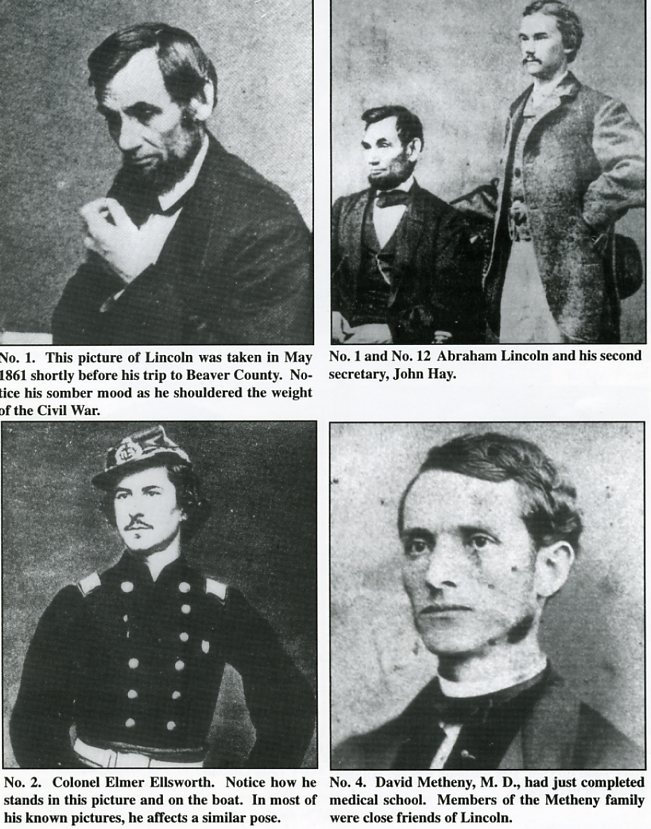
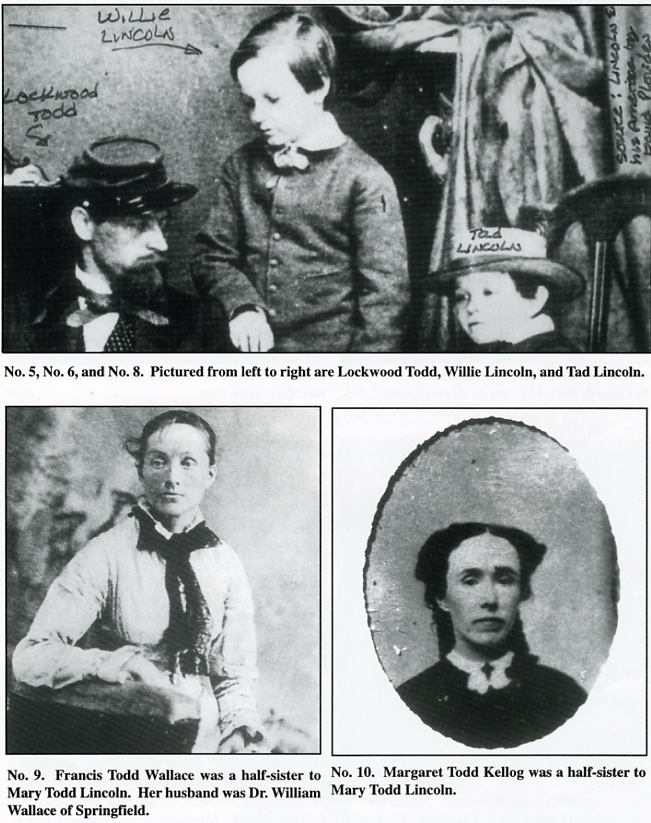
Footnotes
1. The original quarter-plate size ambrotype photograph illustrated as an ambrotype and as print enlargements. It is considered a historically important piece of evidence of this discovery which led to this much researched story and nonfictional article.
2. "Lincoln in Photography, An Album of Every Known Pose" by Hamilton and Ostendorf, 1964, pages 76 - 85, 93 - 101, 105 - 07, 117, ' 150, 321 - 26, McCartney Library. "Dictionary of American Portraits," Cirker, Dover Publications, N.Y, 1967, pages 193, 285, 366, 382 - 84, author's library. "The Image of War 1861 - 65, Shadows of the Storm", Vol 1, P 171, Nat'l. Hist. Soc., authors library. "Lincoln's Sons" by Ruth Painter Randall, Pub: Little & Brown, Boston, 1955, pages 145 - 46, McCartney Library. "Lincoln, An Illustrated Biography" by Kunhardt, foreward by Donald, pages 7, 56, 147, 150-51, 163, 175-79, 224, 251, 1992, author's library. "Lincoln, A Picture Story of His Life", by Stefan Lorrant, Pub: W. W. Norton; N.Y, pages 138,147-49,170-71, 1952, author's library. "Mr. Lincoln's Camera Man, Mathew Brady", by Roy Meredith, Pub: Dover, N.Y, 1974, Illustrations 38, 74, author's library. "Mathew Brady's Portrait of an Era", by Roy Meredith, Pub: W. W. Norton, 1982, pages 99, 101, author's library. "Mathew Brady, Historian With a Camera" by James Horan, Pub: Bonanza, N.Y, illustration no's 146, 156, 421, author's library. "Geneva Alumnus" magazines, 1946, and the "Personal Collections of Dr. Metheny Portraits", owned by Dr. David Carson and Mrs. Theodora Downie Koble.
3. "Noss Glass Negative of Photography Wagon," author's collection and editor's files.
4. Modern "site-photos" in author's and editor's files.
5. "Canal Boat" and "Metheny Family" files, History Center, Beaver Falls Carnegie Library building. "Geneva Alumnus" issues of 1946. Back issues of the "Milestones." Copies of selected pieces from these sources in author's library and in the Foundation files.
6. "The American Conflict, The Great Rebellion of the United States", by Horace Greeley, Vol. 1, 1864, Pub: Case, N.Y, Chicago, Chapter pages beginning 198, 351, 367, 388, 428, 449, author's library. "Lincoln, An Illustrated Biography," by Kunhardt, Pub: Alfred Knopf, 1997, pages 148-51, author's library. "The Prairie Years and the War Years," by Carl Sandburg, Pub: Reader's Digest, 1970, pages 196-211. "Abraham Lincoln, A Biography" by Benjamin Thomas, Pub: Alfred Kopf, N.Y, pages 266-270, author's library. "The Civil War, An Illustrated History" by Geoffry Ward, 1990, pages 34-49, author's library.
7. "Lincoln in the Telegraph Office," by James A. Rawley and David Homer Bates, 1995, Pub: Univ. of Neb. Press, pages 15-55, USF Library, Univ. of S. FLA.
8. "Colonel Elmer Ellsworth, A Biography of Lincoln's Friend and First Hero of the Civil War," by Ruth Painter Randall, 1960, Pub: Little, Brown & Co., Boston, pages 244-48, USF Library, Univ. S. FLA. "Gore Vidal, Lincoln," Pub: Random House, page 170. "Letters of John Hay and Extracts from Diary," Vol. 1, Pub: Gordian Press, N.Y, 1969, pages 33-34, Davis Library, Univ. of N. Carolina. "The Writings of Abraham Lincoln," by Arthur Lapsley, Theodore Roosevelt, Carl Schurz, Joseph Choate, Noah Brooks, Pub: G.P. Putnam's Sons, N.Y, London, 1923, pages 292-93, 297-301, St. Leo College Library, St. Leo, FLA. "Seward at Washington and Secretary of State, A Memoir, 1846-61," by Frederick W. Seward, Pub: Derby and Miller, N.Y, 1891, pages 564-65, Davis Library, Univ. of N. Carolina. "Mary Todd Lincoln, Her Life and Letters," by Turner, Pub: Knopf, 1972, pages 85-87, Craven - PamLico - Carteret Regional Library, Carteret Co, N. Carolina. "With Malice Toward None, The Life of Abraham Lincoln," by Stephen Oates, 1977, Pub: Harper & Row, N.Y, pages 232-35, Carnegie Free Library, Beaver Falls. "Abraham Lincoln, A Biography," by Benjamin Thomas, Pub: Knopf, N.Y, pages 266-270, USF Library, Univ. of S. FLA. "The Atlanta Century," newspapers issued on Sundays, May 12 and 19, 1861, author's library.
9. The "Atlanta Century" newspaper issued on Sunday, May 12, 1861, author's library. "Lincoln Day by Day," Vol 111, 1861-65 by Percy Powell, Pub: Lincoln Sesquicentennial Commission, 1960, page 41, Davis Library, Univ. of N. Carolina. "Mary Todd Lincoln, Her Life & Letters," by Turner, page 87, Pub: Knopf, 1972, Carteret Regional Library, Carteret Co., N. Carolina.
10. "Lincoln Day by Day," Vol 111, 1861-65 by Percy Powell, Pub: Lincoln Sesquicentennial Commission, 1960, page 43, Davis Library, Univ. of N. Carolina.
11. "History of Beaver County, The Heritage Collection," 1888, page 704, Pub: A. Warner, Phila, Chicago., Monaca Pa. Public Library and The History Center at Carnegie Library, Beaver Falls.
12. "History of Beaver County," Vol. 11, page 721, by Rev. Joseph Bausman, Monaca Public Library and the History Center, Beaver Falls.